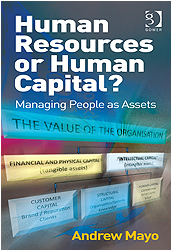Human Resources or Human Capital?

Managing People as Assets
Mayo A. (2012)
Reviewer: Robert E. Jones Oxon – retired senior lecturer
‘Professor Andrew Mayo spent 30 years in large international organisations in a variety of roles, latterly in HR and HR Development. He is Professor of Human Capital Management at Middlesex University Business School, and has been rated by Human Resources magazine consistently amongst the 'top thinkers' in HR. His first books were 'Managing Careers' and 'The Power of Learning' (jointly with Elisabeth Lank, and rated by Carol Kennedy of The Director as 'the best book around on the learning organisation'). His 'Creating a Learning and Development Strategy', first published in 1998, remains a standard CIPD textbook, and in 2001 'The Human Value of the Enterprise' was the culmination of many years' thinking about the challenge of measures for human capital. This was a prequel to the current book. Andrew is a regular writer, speaker and consultant on strategic issues in people management.’
It appears these days to be an age old adage; ‘our people are our most important asset’. I once worked for a company with a mission statement that began ‘People are our most important asset…’ and they completely failed to live up to it. The result was disastrous: a growing lack of trust of senior management. When things went wrong as of course they can and do there was simply no reserve of trust for the management to fall back on, the company faltered repeatedly and sadly it ultimately failed. Prior to the end, like many others, I’d already left. However, the carte blanche statement remains a truism for even as the company mentioned failed, that’s not to say that they didn’t mean what they said. Whilst it is true that some people within organisations may be liabilities but others provide the most important of ‘drivers’ an organisation can have. However the key is identifying who these people are, how do you know and how might you maximise the value that they provide? In this context answering these questions is what Human Capital Management is about. It makes little difference whether an organisation is private or publicly owned for in the main success depends firstly and foremost on the capability of people and secondly on the commitment and productivity of those self-same people. This book discusses how to ensure the most effective management of these ‘value creating’ assets. The preliminary part of the book shows just how to create an integrated framework of measures that can fast become part of the organisation’s performance management coupled with the actuality of ‘how’ some companies have achieved this in practice. The work goes on to recognise that despite the need to be so the HR function in organisations is often not that deeply involved, relevant and supportive of the business and its strategies. The second part of the book shows how to do this both strategically and successfully, and how HR can serve as a credible ‘business partner’ that enables managers to achieve their goals by way of their people and in so doing add real value the organisation and all its stakeholders. The book includes throughout ‘action challenges’ and several practical examples of the application of its messages.
Contents:
Introduction: The essential need for human capital management;
Part 1 People and value creation: How organisations create value through people
The value of people themselves; Motivation, engagement and performance
Integrating and reporting human capital measures
Part 2 Human resources professionals in partnership with the business: The contribution of the HR professional to more effective business performance
People and organisation strategies derived from the business strategy
A score card for the HR function; Building human capital management skills
Appendix: examples of non-financial added value to stakeholders
Index


